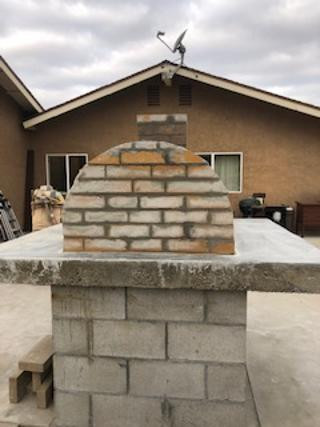I had some “help” that wasn’t too helpful and came home to this. Step 24 clearly says to keep the mortar joints 1/8" and this turned out 1/2 inch. Do I need to rip it out and redo?

Hi, Nancy, and welcome to the BrickWood forums.
Well, that’s not optimal in relation to the instructions. You probably lose a little of the refractory “magic” of the firebrick from the back wall. Unlike the sides which are built in that beautiful barrel arch the back wall is a flat surface and gets the job of backing up your pizza-grade flame bed. That would be the main reason for thin joints.
But wait… On the other hand, you stilll have a good proportion of brick to mortar. And, your “little helper” clearly has a way with trimming brick properly to get the edges conformed to the barrel shape. Seeing those edges persuades me that that mortar, in all its abundant glory, is laid in properly to seal the spaces between the brick, and you won’t lose much.
So, my personal opinion is that no, you should not tear it out. Do make sure that your mineral fiber across the back wall overlaps the arch blanket at all points, and when you cure the oven later, you’ll want to push some of the live coals to the rear so that the mortar in that area gets enough heat exposure to get rock-hard.
You might want to give your “helper” a measuring gauge for future brick-laying adventures!  But focus on the positive, and remember this is supposed to be fun.
But focus on the positive, and remember this is supposed to be fun.
Good luck, Nancy, and please let us know about your progress. You’ve got a beautiful oven going there!
maybe a couple of extra layers of that blanket might help too?
I don’t think so. The joints are really not that big of a deal in the overall scheme of things. Mineral fiber will help with heat retention, which is not the same as heat refraction. Do the recommended blanket layer over the back.
This has much to do with the final uses for your oven. When you’re baking pizza, you want a very hot flame at the rear. The bricks have to be able to take the stress of flames licking up that rear wall, and a 3- to 4-inch deep bed of live coals at its base. That’s why I’m glad to see the mortar joints look full and evenly spread, and why I recommend you pay extra attention to curing at the rear.
For applications where you want to retain heat, primarily roasting and baking, the insulation comes into full play. Those fires are set more along one side of the oven, and the flames are meant to “soak” heat into the entire oven cavity rather than rely on infrared and refracted energy. That’s the job of the mineral fiber blanket. The firebrick will become thoroughly heated, and you don’t want that heat to escape into the atmosphere. The relevant point here is that most of that heat, by design, is going into the arch rather than the back wall.
As much as I’m sure mineral fiber manufacturers (and BrickWood) would appreciate the extra business, adding more fiber on the back wall will not improve anything.
And once again, I do not believe that the “extra” mortar has done anything to mar your oven. Just pay attention to curing in the rear section and you will be fine.